A frequently asked question is "What is the difference between all felting needles?". Therefore, we decided to list all the facts for you in this article called "felting needles explained"! In this blog post, we will discuss the different types of felt needles and their applications. With this information, you will know exactly which felt needle to buy and use for your projects.
Want to buy felting needles right away? You can see links to the products at the bottom of the page or go now here to the felt needles category
What Are Felting Needles and How Do They Work?
Felting needles are specialised needles used in the process of dry felting. These needles have barbs along the shaft that interlock and entangle the wool fibres as they are inserted into the wool. This process of repeatedly poking in and out with the needle ensures that the fibres adhere firmly together, creating a dense and sturdy fabric. Felt needles are essential for creating three-dimensional felt sculptures and for adding fine details to felt projects.
Types of felting needles
There are many different types of felting needles. For convenience, we divide them into four categories, arranged by shape: three-sided, four-sided, twisted and reverse needles. Note that felt needles are sharp and fragile, so be careful when using them.
Correct handling of felt needles
Felting needles are fragile, so make sure you always insert the needle straight into the wool and also take it out at the same angle. Avoid sideways pressure and try not to wiggle the needle. It is useful to always have some extra needles around the house in case one breaks. If the pressure on the wool is too low or too high, change to a finer or just coarser needle, depending on your project.
Gauge of felt needles
The gauge of a felt needle refers to the diameter of the needle. The higher the gauge, the finer the needle and the narrower the barbs. The first digit indicates the number of sides, the remaining numbers refer to the gauge (e.g. felt needle 332: 3 = 3-sided, 32 = 32 gauge).
Different felting needles and their Applications
Regular felting needles
332: A universal needle for coarse to medium fine wool. Ideal for quickly modelling a basic shape and attaching pieces of wool to large surfaces. This needle may cause an uneven, perforated surface on fine material.
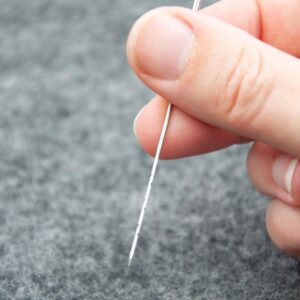
340: A fine needle for detail work and an even surface. Suitable for working with fine wool and for applique work. Not suitable for very coarse fibres or rough sculpting.
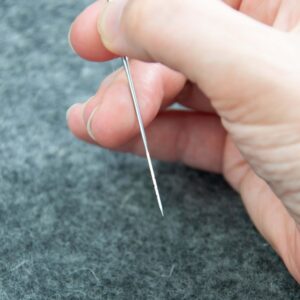
343: Suitable for very fine wool, appliqué work on fine fabrics such as silk, and for pricking very fine details.
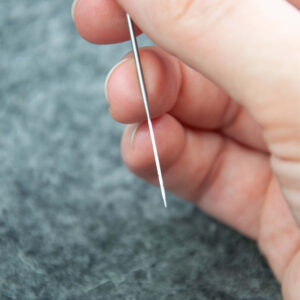
Besides normal felting needles, there are special needles such as four-sided felting needles and reverse felting needles and twisted felting needles:
Four-sided Needles
438: A four-sided needle, ideal for working with fine wool such as merino. Perfect for spreading evenly on a basic shape already felted with the coarse felting needle. Due to the extra barbs, this needle felts faster, especially for superficial and detailed work.
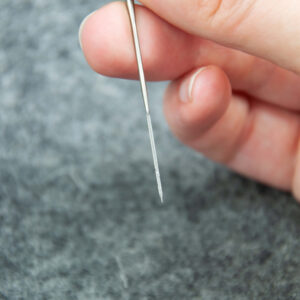
Reverse/Felting Needle
R32: This needle has barbs in the opposite direction, allowing you to pull fibres out of the felt. Ideal for creating furry textures or mixing different colours.
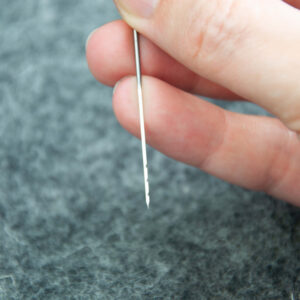
Twisted/Turned Felting Needle
T40: This needle has barbs on twisted ribs, allowing you to use the entire cross-section of the needle. This makes the needle more effective and faster to use.
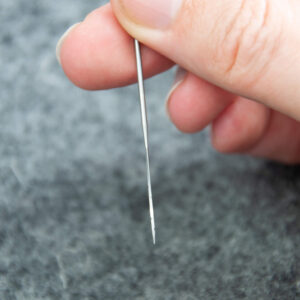
Tips for using felt needles
- Always use the right needle for your project: Thin needles for fine details, medium needles for general applications, and thick needles for coarse wool and, for example, with children (thick needles break a little less quickly).
- Be careful: Felt needles are fragile, so always work carefully and move the needle up and down and NOT back and forth to avoid breakage.
- Keep extra needles handy: Just in case a needle breaks, so you can continue with your project.
More information and help
Want to know more about felting needles or need help choosing the right needle? Then visit our website or send us a message. We will be happy to help.
Don't forget to tag us at Instagram @meaningful.crafts or Facebook with your felting projects. We love to see what you've made!
With these tips and tutorials on felting needles, you'll be ready to get started on your felting projects. Good luck and have fun!

